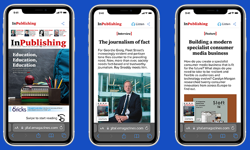I’m going to start with a question. Why is it that there are often more people on the subscriptions acquisition team than on the retention team? My background is in loyalty marketing, where the converse, in general, appears to be true. Look at frequent flyer programmes and you will see the main drive is towards servicing, retaining and developing the membership, and these activities far outweigh the resources allocated to bringing in new members. "It’s a different industry", I hear you say, and of course you’re right, but the main difference here is that they have learnt to focus on taking the customer on an individual journey, building loyalty to the extent that they would not consider going elsewhere and they tailor their communications accordingly.
We are operating in an exciting time for publishing. The growth in momentum of direct to consumer marketing over the past decade has focused attention on the subscriber base. (Although much of the message that I have today will focus on the consumer market, many principles can be carried across to the B2B sector). As a result of this growth, we have seen tremendous work across the industry from the subscription marketing teams who have pushed the creative boundaries to identify new routes to get new subscribers. We are now seeing subscriptions sold in store and redeemed with loyalty points, as well as through the traditional methods of direct mail, page ads and inserts. In the meantime, subscribers have a greater choice of alternative publications. If their requirements are not met, they can and will change allegiance; they have become fickle and publishers have, to a great extent, encouraged this through concentrating efforts on low prices. As publishers, we need to regain control and direct the customer journey by anticipating their changing motivations and needs.
With greater subscriber choice and the expansion of routes to market, the role of the renewal strategy has become far more complex. This means a greater focus on segmentation of renewal communications than ever before.
Why segment your renewals?
Is there ever a case where you don’t need to segment subscription renewals? Perhaps in an environment where all subscribers are within the UK, paying the same rate, of a similar age, same sex, are happy to communicate via the same media channel, and never buy subscriptions for other people. Otherwise, we need segmentation in order to make sure that the message that we are communicating is relevant to each sector of our market and consistent with that given to our subscribers at acquisition.
It is worth bearing in mind that often the only communication that the subscriber will receive about their current subscription will be their renewal notices and, in some cases, acknowledgement of receipt of order. So, segmenting the renewal notice to ensure that the message fits the subscriber is of paramount importance to building your relationship and securing long term loyalty.
Just because a group of individuals all subscribe to the same publication, it doesn’t make them a single homogenous audience. There are distinct groups of subscribers who have different needs and motivations. To start with, there are very different circumstances surrounding their reasons for purchasing a magazine subscription. These might include:
1. It saves money over newsstand purchase. In this instance, price is the main driver.
2. It had an attractive premium gift. The perceived value of the promotional gift tipped the balance in favour of this magazine over other alternatives.
3. Interest in the subject matter. They are looking to be more informed on a certain subject. Price is of less significance, but quality of content and fast delivery of each issue is of prime importance.
4. Moving abroad or to a rural location. The subscriber may not be able to continue to buy their favourite magazine off the newsstand. Delivery to the door is of paramount importance.
5. A gift for someone. The purchaser may know little about the product and will look to see where they can take up the subscription most conveniently and at the right price. Promotion of the magazine is a strong influencer here, aligning the image of the product to the purchaser’s image of the individual for whom it is intended.
6. It represents values that the buyer has, or aspires to have. Again, promotion and product are of paramount importance as the brand is aligned with personal aspirations. Price can also play a part in this motivation as a high price publication can infer exclusivity.
7. It is available through points on a loyalty scheme. The perception is that "they might as well subscribe" as they are not paying for it.
8. It contains information that supports your profession. For instance, beauty magazines going to hairdressers.
9. It provides market intelligence in the B2B marketplace.
10. Multiple copies may be purchased for public access in libraries, waiting rooms or receptions.
Just as there can be a variety of reasons for taking out a subscription, there can be the same variety of reasons for renewing it.
Renewal copy that re-enforces magazine content and values will work well for the private reader but will need to be rewritten for the gift donor and may be of little interest to a corporate buyer of consumer magazines.
Emphasis on price alone may be applicable to the corporate buyer but will lose the opportunity to build the brand in the private reader’s eyes and will focus their attention on the cost to them rather than product benefits.
If a subscriber has taken advantage of combination deals or an extended subscription term, then it would make sense that they are offered a similar package at renewal time. If you take them back to a standard 12 month renewal on one magazine, then you are missing an opportunity.
Within your subscriber base, you will have subscribers of various lengths of tenure. Some will have renewed for the first time and others will have been renewing for years, so the levels of loyalty to the publication will vary. Loyal customers may place a higher value on increased benefits than on discounted price.
Traditionally, renewals have been segmented into the following core groups:
* Individual subscriptions – sometimes further segmented by price point or number of times renewed.
* Gift Donors – sometimes using different copy to the individual subscriber and often giving details of the recipient of the gift. This avoids confusion if more than one gift is being given. Again this may be further segmented by price and times renewed.
* Gift Recipients – where the donor fails to respond, focus can change to the recipient.
* Overseas – normally need to be identified separately for postage and price point.
* Special discounted groups – staff and partner discounts may be available on a different price strategy.
But, with the use of database analysis, these segments can be extended into areas such as individual profiles, behaviour, media channel and propensity to purchase. If the data is there, the only limit is your imagination.
Barriers to greater segmentation
Many publishers would happily create more segments but are limited by costs and the current paper based production systems that they have selected to use. The more segments you have; the more letters you create; the higher the set up costs; ergo, cost prohibitive communications.
So, with growing numbers of segments created by more creative acquisition campaigns, how can the industry continue to handle segmented renewals effectively?
We need the same level of creative thinking in renewals to match the advances in acquisitions.
Review your use of production techniques with your subscription handling house and discuss ways in which you can expand your ability to segment by changing production methods, perhaps by expanding the use of variable text.
Explore and test new media channels. If your subscribers are communicating via web, SMS or email then test and explore selective multi-channel renewals. This will be less costly and more in tune with the preferences of your subscriber … and it’s eco-friendly.
Develop your database and look at the use of propensity modelling to create triggered renewals at the right time, via the right channel and with the right message.
Apply digital processing to output renewal letters or emails and go one step further … individualise! With today’s technology you could, if it tested well, send out a thousand different communications to a thousand readers, rather than the same one.
Importance of planning
Renewals are an essential part of your acquisition planning. The customer journey needs to be planned from the start and the offer and message needs to be consistent. Look at the entry deal and consider who will take up this offer and how the subscriber will be incentivised to stay. With so many acquisition campaigns based on low price and attractive premiums, it can become difficult to retain these subscribers; raise the bar too high and they will go. Acquisition based on product benefit provides a much stronger basis for renewal.
Pay attention to internal housekeeping. If analysis of the subscription data highlights a plethora of price points that are not part of your overall strategy, then don’t make them a permanent feature of renewals, instead correct them at source. Don’t set up segments to accommodate features that you would rather not, and don’t need to, have.
Make sure that your fulfilment house can handle your proposed changes. Discuss your requirements and any changes to the current system with them from the start.
It is essential that all ‘payment’ methods are accommodated. Where magazine subscriptions are offered as points redemption on a third party loyalty campaign, then consider how they will renew.
Be aware of what is going on in acquisitions at the time your renewal notices are being despatched. If a subscriber receives a renewal letter offering 20% discount on newsstand prices when the magazine is offering an acquisition discount of 30%, then guess which one they will go for?
Don’t assume that all segments need the same number of efforts. Test first and then roll out the appropriate number of renewal efforts for each segment.
And finally, don’t forget to listen to your subscribers and take notice of how they behave. By responding to your subscribers’ preferences and relating to their motivations, you will reap the benefits in higher and more profitable renewals.
FEATURE
Slicing it right
This may come as a bit of a shock, but publishers can learn something from the direct marketing techniques used in other industries! Hard to imagine, I know. What is particularly interesting, says Debbie Stenning, is to look at the relative importance different industries attach to customer acquisition and retention.










